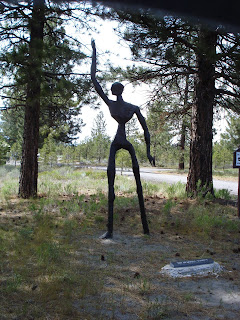Got a chance to play some tennis with the local USTA Eugene team going to sectionals; good players (primarily indoor hard courts). Also played with Buzz Summers, long time coach of U of Oregon's tennis team; at 73, he is still a wonderful player (someone told me that he was ranked as high at #5 nationally about 10 years ago).
 Oregon is very organic, very progressive and very independent. Eugene has a great farmer's market downtown; all these people with advanced degrees selling their organic fruits and vegetables. Can they make enough to send their kids to college?
Oregon is very organic, very progressive and very independent. Eugene has a great farmer's market downtown; all these people with advanced degrees selling their organic fruits and vegetables. Can they make enough to send their kids to college? "Where have all the flowers (flower children) gone?" "Gone to Eugene, every one." Felt like we were in a time warp from the 60's. Hippy Diffy Weatherman definitely here. Everything is Peace, Love and Full Self Expression. Woodstock is here!
"Where have all the flowers (flower children) gone?" "Gone to Eugene, every one." Felt like we were in a time warp from the 60's. Hippy Diffy Weatherman definitely here. Everything is Peace, Love and Full Self Expression. Woodstock is here! Got a chance to have dinner with Marsha and Flavio, good Pa. friends (did not get a good picture). Just like old times, great. Met in Corvallis, home of Oregon State University.
Got a chance to have dinner with Marsha and Flavio, good Pa. friends (did not get a good picture). Just like old times, great. Met in Corvallis, home of Oregon State University.Visited Salem, Oregon's capital. Nice tour of the Capitol building. Both House and Senate work for six continuous months then are off for eighteen months. People don't want their reps to be professional politicians. Hmm, maybe they have something there. Below, Marlene with our tour guide, David Schmidt; excellent docent.
 Also did a tour of the Asahel Bush house; built in late 1800's. Sinks in the women's bedrooms had faucets that they pinched rather than turned, so they would not build up unsightly masculine muscles on their wrists.
Also did a tour of the Asahel Bush house; built in late 1800's. Sinks in the women's bedrooms had faucets that they pinched rather than turned, so they would not build up unsightly masculine muscles on their wrists.
 Also did a tour of the Asahel Bush house; built in late 1800's. Sinks in the women's bedrooms had faucets that they pinched rather than turned, so they would not build up unsightly masculine muscles on their wrists.
Also did a tour of the Asahel Bush house; built in late 1800's. Sinks in the women's bedrooms had faucets that they pinched rather than turned, so they would not build up unsightly masculine muscles on their wrists.


























